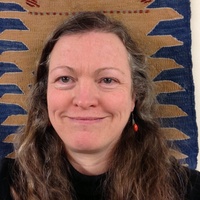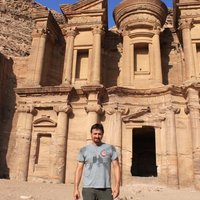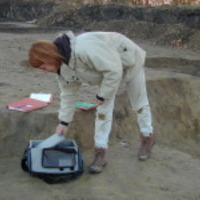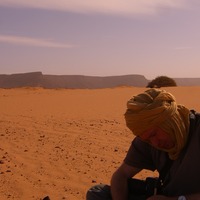
Claus Kropp
Related Authors
Nerissa Russell
Cornell University
Enrico Cirelli
Università di Bologna
Florin Curta
University of Florida
Viktória Kiss
Hungarian Academy of Sciences
Christophe Wardius
Université Paris 1 - Panthéon-Sorbonne
Carlo Citter
University of Siena / Università di Siena
Andrew Wilson
University of Oxford
Federico Zoni
Università degli Studi di Bergamo (University of Bergamo)
Sławomir Wadyl
University of Warsaw
InterestsView All (7)










Uploads
Papers by Claus Kropp
archaeological feature which refl ect an agricultural
field type which was widely common until the 19th
century. Today there are nonetheless many open
research questions concerning the actual use, function
and interpretation of ridge and furrows within Medieval
agriculture. The Lauresham Open-Air Laboratory
together with the Martin-Luther-University Halle-
Wittenberg is therefore conducting therefore large scale
field studies with (re)constructed and newly created
ridge and furrows systems on site. Both institutions not
only hope to widen our historical knowledge on this
field system but to possibly give relevant impulses to
21st century sustainable farming.
known archaeological features within Early Medieval
settlement archaeology. Nevetheless not much is known
concerning the specifi c function and interpretation of
these house types. A new research project at the Open-
Air Laboratory Lauresham is trying to counter this using
an experimental archaeological approach.
landscapes of Europe and beyond. With the Auerrind-
Project, the Open-Air Laboratory Lauresham both aims
to widen our knowledge of wild Aurochs in the holocene
and to give visitors answers to the question, what
wilderness and nature in the Early Middle Ages meant
and how aurochs played an important role culturally
(prestige hunting, domestication e.g.) and naturally (as
large grazers). With fi rst results already appearing, the
project follows three paths to fulfi l its general aims:
breeding an aurochslike cattle breed, research and
natural grazing.
Claus Kropp / Dieter Lammers
role within the framework of Carolingian warfare.
As part of their duties (militia) they had to equip
and provide mounted and armoured warriors
(loricati milites; German “Panzerreiter”) for the
imperial army. With a new and interdisciplinary
research project, the UNESCO World heritage
site Lorsch Abbey together with the Lauresham
Open-Air Laboratory tries to find out more about
social status, appearance and the equipment of
said “Panzerreiter”. As part of this project, it is the
long-term goal to (re)construct every single known
piece of equipment a mounted warrior like this
would have had and to present it in a museum
context at the World Heritage Site. In a first
step, a team of craftspeople, archaeologists and
archaeotechnicians worked on the (re)construction
of a Carolingian damask spatha found near
Mannheim-Neckarau in 1932. This paper presents
the results of a first phase in which it was the main
goal to get an idea of the techniques and material
used to create this extraordinary sword. The usage
of modern tools and other auxiliaries was in this
case allowed. A yet to be accomplished second
phase of the project then wants to craft a second
(re)construction under authentic basic conditions.
in the field of agriculture. This paper addresses
the question on how medieval farmers and the
manorial system might have coped with situations
like this. Did medieval subsistence strategies like
risk minimization result in advantages which could
be of use for modern agriculture? The Lauresham
Open-Air Laboratory for Experimental Archaeology
at the UNESCO World Heritage Site Lorsch Abbey
in Southern Germany delivers valuable answers
to questions like this. As a scale 1:1 model of
an Early Medieval manor it functions as a vast
basis for experiments in the fi eld of Experimental
Archaeology, Agriculture and Ancient Crafts.
On almost more than one hectare, the Open Air
Laboratory conducts experiments on the function,
advantages and disadvantages of different field
systems of the Early Middle Ages including ridge and
furrows. Using (re)constructed medieval ploughs
and draft cattle, it is the goal to create as authentic
conditions as possible for the scientific experiments.
A professional weather station, soil analysis,
growth monitoring of the diff erent crops and the
calculation of the maximum draft power needed
for the various agricultural implements all allow
deep and new insights on the value of medieval
subsistence strategies for 21st century agriculture.
Books by Claus Kropp
archaeological feature which refl ect an agricultural
field type which was widely common until the 19th
century. Today there are nonetheless many open
research questions concerning the actual use, function
and interpretation of ridge and furrows within Medieval
agriculture. The Lauresham Open-Air Laboratory
together with the Martin-Luther-University Halle-
Wittenberg is therefore conducting therefore large scale
field studies with (re)constructed and newly created
ridge and furrows systems on site. Both institutions not
only hope to widen our historical knowledge on this
field system but to possibly give relevant impulses to
21st century sustainable farming.
known archaeological features within Early Medieval
settlement archaeology. Nevetheless not much is known
concerning the specifi c function and interpretation of
these house types. A new research project at the Open-
Air Laboratory Lauresham is trying to counter this using
an experimental archaeological approach.
landscapes of Europe and beyond. With the Auerrind-
Project, the Open-Air Laboratory Lauresham both aims
to widen our knowledge of wild Aurochs in the holocene
and to give visitors answers to the question, what
wilderness and nature in the Early Middle Ages meant
and how aurochs played an important role culturally
(prestige hunting, domestication e.g.) and naturally (as
large grazers). With fi rst results already appearing, the
project follows three paths to fulfi l its general aims:
breeding an aurochslike cattle breed, research and
natural grazing.
Claus Kropp / Dieter Lammers
role within the framework of Carolingian warfare.
As part of their duties (militia) they had to equip
and provide mounted and armoured warriors
(loricati milites; German “Panzerreiter”) for the
imperial army. With a new and interdisciplinary
research project, the UNESCO World heritage
site Lorsch Abbey together with the Lauresham
Open-Air Laboratory tries to find out more about
social status, appearance and the equipment of
said “Panzerreiter”. As part of this project, it is the
long-term goal to (re)construct every single known
piece of equipment a mounted warrior like this
would have had and to present it in a museum
context at the World Heritage Site. In a first
step, a team of craftspeople, archaeologists and
archaeotechnicians worked on the (re)construction
of a Carolingian damask spatha found near
Mannheim-Neckarau in 1932. This paper presents
the results of a first phase in which it was the main
goal to get an idea of the techniques and material
used to create this extraordinary sword. The usage
of modern tools and other auxiliaries was in this
case allowed. A yet to be accomplished second
phase of the project then wants to craft a second
(re)construction under authentic basic conditions.
in the field of agriculture. This paper addresses
the question on how medieval farmers and the
manorial system might have coped with situations
like this. Did medieval subsistence strategies like
risk minimization result in advantages which could
be of use for modern agriculture? The Lauresham
Open-Air Laboratory for Experimental Archaeology
at the UNESCO World Heritage Site Lorsch Abbey
in Southern Germany delivers valuable answers
to questions like this. As a scale 1:1 model of
an Early Medieval manor it functions as a vast
basis for experiments in the fi eld of Experimental
Archaeology, Agriculture and Ancient Crafts.
On almost more than one hectare, the Open Air
Laboratory conducts experiments on the function,
advantages and disadvantages of different field
systems of the Early Middle Ages including ridge and
furrows. Using (re)constructed medieval ploughs
and draft cattle, it is the goal to create as authentic
conditions as possible for the scientific experiments.
A professional weather station, soil analysis,
growth monitoring of the diff erent crops and the
calculation of the maximum draft power needed
for the various agricultural implements all allow
deep and new insights on the value of medieval
subsistence strategies for 21st century agriculture.